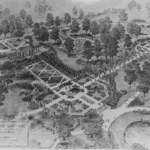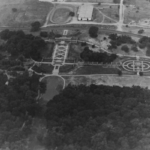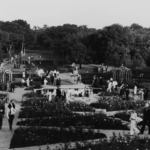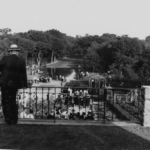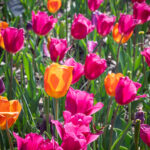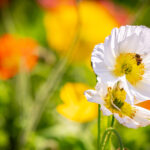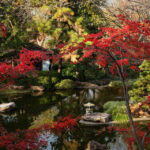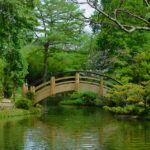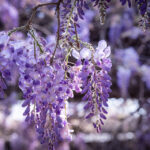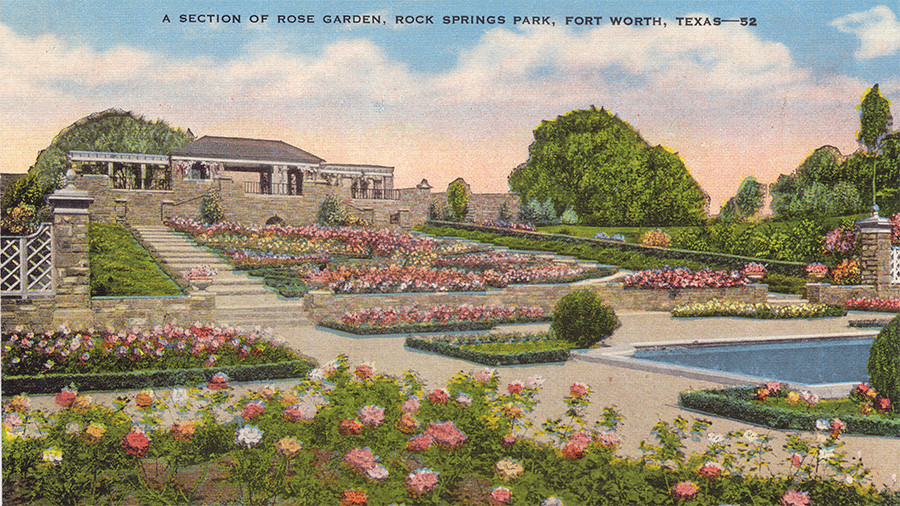
Fort Worth Botanic Garden’s 90th Birthday
By Jackie Ferguson
Photos courtesy of Fort Worth Botanic Garden
Growing with Fort Worth for Generations
The Fort Worth Botanic Garden turns 90 on Dec. 18 and is inviting the entire city to the party. Guests can enjoy the 120 acres of lush foliage, tranquil ponds and free admission. Located just 3 miles from downtown Fort Worth, the FWBG has welcomed millions of guests over the last nine decades. Its history is as rich and diverse as the more than 2,500 native and exotic plant species that adorn the Garden today.
Patrick Newman, president and CEO of the FWBG and the Botanical Research Institute of Texas (BRIT), sees the Garden as “a space to roam, have an opportunity for quiet, contemplative moments and to celebrate.” He affectionately refers to those celebratory moments as “emotional souvenirs,” including events like birthdays, first dates, anniversaries, weddings and engagements. Lots of engagements. A reported 47 marriage proposals occurred during last winter’s Lightscape event alone.
Newman often hears “wonderful personal stories” about people’s fondest memories of visiting the Garden. “At 90 years old, the Garden has granted generations of experiences for visitors,” he says.
The Garden has grown and changed through a collaborative effort of funding and leadership from the Fort Worth Garden Club, the Fort Worth Park and Recreation Department, the FWBG staff, individuals and corporations and the City of Fort Worth.
“We would not be where we are today without generations of stewardship, and the love and support of the community,” Newman says.
Planting the Seed
At the turn of the 20th century, members of the Fort Worth Board of Park Commissioners had a goal of developing a botanic garden, what they described as “an outdoor library of living plants” to display Southwest native flora.
In 1912, the City of Fort Worth spent $7,500 on 37.5 acres to establish a park, which it aptly named Rock Springs Park because of the natural springs on the tract. Thirteen years later, the city passed a $300,000 bond package to commission a more comprehensive park system design plan. During this phase, the American Rose Society suggested featuring — you guessed it —roses. In 1930, landscape architectural firm Hare & Hare of Kansas City, Missouri, obliged with a Rose Garden design reminiscent of the Gardens of Versailles.
Rock Springs Park phase one was completed a year later. The design incorporated the natural springs and included sandstone imported from Palo Pinto County to construct waterfalls, spillways and pools. Raymond C. Morrison, the city of Fort Worth forrester from 1926-1938, recalled in his “Remember” column in the May/June 1977 issue of The Redbud that problems arose when soil and stones added to form the manmade lagoon would not retain water.
“We soon discovered that the water disappeared underground,” Morrison wrote.
The solution was economical and innovative — a female elephant named Queen Tut from the Fort Worth Zoo came to the rescue. When the popular pachyderm wallowed in the lagoon, she packed down the soil, and the lagoon held water. Today, visitors can still enjoy the calming sounds of waterfalls and the beauty of the lagoon, thanks to Queen Tut and her special splash day.
Watching it Bloom
Even with landscape design plans in hand, the city could not start construction on the Rose Garden due to the stock market crash of 1929. Fiscal measures taken in response to the Great Depression offered a financial solution. Congress established the Reconstruction Finance Corporation in 1932 to loan money to state and local governments for public infrastructure projects. The City of Fort Worth and the Tarrant County Commissioners Court jointly applied for $340,000 from the RFC in October of 1932. Because they included detailed plans for design and construction, the grant was quickly approved.
By February of 1933, relief funds were issued and the city hired 450 unemployed men through the Civil Works Administration, making it one of the first Depression Era relief projects in Fort Worth. Laborers worked two-day shifts, the maximum number of hours allowed per week per man by the RFC, for $2 a day, which usually came in the form of meal tickets, according to “A History of the Fort Worth Botanic Garden” printed in 1983 by the Fort Worth Park and Recreation Department. Many of the laborers were undernourished, so lunch was served most days for the crew, often cooked by N.E. Archie, who later founded Archie’s Gardenland, a west Fort Worth nursery still in business today.
More than 4,000 tons of sandstone was imported from cliffs in Palo Pinto County to build the hilltop shelter house, the terraces and intersecting walkways that crisscross through the roses, and the cascading water feature and reflecting pool. Although originally estimated to take years to complete, the project was done in just nine months thanks to the hundreds of laborers on the job. On Oct. 15, 1933, the Rose Garden was dedicated. Many of the CWA laborers and local nursery men donated the original roses for the garden.
Two Texas Firsts
On Dec.18, 1934, Rock Springs Park and the new Rose Garden were officially renamed the Fort Worth Botanic Garden by the board of the Park Commissioners, making it the oldest botanic garden in Texas. Another first occurred in June of 1935 when the Fort Worth Garden Club opened what today is known as the Rock Springs Building, making it the first established garden center in Texas. Started as an adjunct of the Fort Worth Women’s Club, the Garden Club will celebrate its 100th anniversary in April 2026.
For the Birds
A popular holiday tradition began in December 1935 with the first annual “Birds’ Christmas Tree.” Mimicking a Scandinavian custom, children were encouraged to decorate an old mesquite tree near the Garden Club’s greenhouse with strings of cranberries, apples, carrots, cornbread crumbs and popcorn for the birds to eat. The Garden Club members wanted to attract birds to the Garden, and, apparently, their efforts were quite successful. In December 1953, the Fort Worth Audubon Society designated part of the FWBG as a bird sanctuary. Today, a number of the Garden’s members and visitors are bird watchers, exploring the grounds with their binoculars, cameras and journals to record their latest bird sightings. The local Audubon Society also leads tours of the Garden throughout the year.
Serenity and Culture
Relaxing or meditating in the peaceful Japanese Garden today, it is hard to imagine that it was once a gravel pit and later a dumping ground for debris from Camp Bowie when the military training facility closed after World War I. But, thankfully, leaders at the Fort Worth Park and Recreation Department saw its potential. Amid the mounds of horse manure, industrial trash and weeds was a wilderness featuring “five distinct levels with dozens of twisting, bending trees – inspiration for the maker of the garden,” recounted Morrison. In 1968, Kingsley Wu, a professor of environment living at Texas Women’s University, was hired to develop the final designs for what is now the 7.5-acre Japanese Garden, featuring meandering paths amid rich foliage, tranquil water features teeming with koi fish, which were originally donated in 1973 by Alice Foster and husband J.E. Foster Jr., a Fort Worth family of real estate developers in the 1950s through 70s. The much-photographed moon bridge and pagoda, many stone sculptures and the serene meditation garden make this one of the most peaceful places in Texas. Dedicated in 1973, the Japanese Garden is wildly popular today, and the site of a Japanese Festival in both the fall and spring.
Additional Growth
In 1976, the Garden Club funded the planting of 200 trees at the Garden to celebrate the nation’s Bicentennial, Garden Club historian Melinda Burt says. Over the years, 23 unique areas have been developed throughout the Garden, including the Republic of Texas Rose Garden in 1982. Featuring rose varieties that grew in the state when it was known as the Republic of Texas in 1836-1845, the historically significant roses were propagated from original cuttings or roots, not grafts. The iconic 18-foot-diameter floral clock at the Garden’s entrance was added in 1995. A gift from the Garden Club, the plants adorning the clock’s face change seasonally. Buildings have been added as well, including the 17,000-square-foot Deborah Beggs Moncrief Garden Center and the adjacent 10,000-square-foot tropical conservatory, also funded by the Garden Club.
Research and a Merger
The BRIT moved to its LEED, platinum-certified headquarters within the grounds of the Garden in 2011. The building’s distinctive design includes a “living” roof featuring flowering plants of the Fort Worth prairie. An international scientific research and learning center, BRIT curates one of the largest herbarium collections in the nation, with nearly 1.5 million plant specimens from around the world. The BRIT Research Library houses about 125,000 volumes of botanical books and journals. Tours and classes are available to the public. In 2020, BRIT took over management of the garden from the city of Fort Worth for a 20-year term.
Modern Accolades
The Garden has won many awards over the years, and more recently was selected as one of “the South’s Most Beautiful Gardens” by Southern Living magazine in 2024; called “the most peaceful spot in Texas and one of the quietest city spots in the U.S.” by Earth.fm, an environmental non-profit; and earned a coveted Traveler’s Choice Award from Tripadvisor, based on reviews and ratings over a 12-month period. In 2009, the garden was placed on the National Register of Historic Places. It has grown and changed over the years, always striving to be a place of community, beauty and learning.
“The Fort Worth Botanic Garden, along with our world-class museums, award-winning zoo, vibrant downtown and thriving Cultural District, makes our city an exceptional place to live and a beloved destination for visitors,” Fort Worth Mayor Mattie Parker says.
The Next 90 Years
Newman says that over the past 90 years, the Garden has done a great job of preserving the past, addressing the present and planning for the future. “It is safe to assume that 90 years from now, we will still have a community that loves and supports this garden. That people will come to learn, be inspired and find healing. Many things may change, but at our core, the garden will still be about truth, about beauty and about community,” he says.

